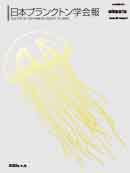Volume 69, Issue 2
Displaying 1-22 of 22 articles from this issue
- |<
- <
- 1
- >
- >|
Obituary
-
2022Volume 69Issue 2 Pages 81-82
Published: August 25, 2022
Released on J-STAGE: September 17, 2022
Download PDF (1907K)
Original Papers
-
2022Volume 69Issue 2 Pages 83-92
Published: August 25, 2022
Released on J-STAGE: September 17, 2022
Download PDF (925K) -
2022Volume 69Issue 2 Pages 93-101
Published: August 25, 2022
Released on J-STAGE: September 17, 2022
Download PDF (587K)
Research Information
-
2022Volume 69Issue 2 Pages 102
Published: August 25, 2022
Released on J-STAGE: September 17, 2022
Download PDF (262K) -
2022Volume 69Issue 2 Pages 102-103
Published: August 25, 2022
Released on J-STAGE: September 17, 2022
Download PDF (304K) -
2022Volume 69Issue 2 Pages 103
Published: August 25, 2022
Released on J-STAGE: September 17, 2022
Download PDF (299K) -
2022Volume 69Issue 2 Pages 104
Published: August 25, 2022
Released on J-STAGE: September 17, 2022
Download PDF (261K) -
2022Volume 69Issue 2 Pages 104-105
Published: August 25, 2022
Released on J-STAGE: September 17, 2022
Download PDF (296K) -
2022Volume 69Issue 2 Pages 105
Published: August 25, 2022
Released on J-STAGE: September 21, 2022
Download PDF (289K) -
2022Volume 69Issue 2 Pages 105-106
Published: August 25, 2022
Released on J-STAGE: September 17, 2022
Download PDF (296K) -
2022Volume 69Issue 2 Pages 106
Published: August 25, 2022
Released on J-STAGE: September 17, 2022
Download PDF (276K) -
2022Volume 69Issue 2 Pages 107
Published: August 25, 2022
Released on J-STAGE: September 17, 2022
Download PDF (292K) -
2022Volume 69Issue 2 Pages 107
Published: August 25, 2022
Released on J-STAGE: September 17, 2022
Download PDF (292K) -
2022Volume 69Issue 2 Pages 107-108
Published: August 25, 2022
Released on J-STAGE: September 17, 2022
Download PDF (319K) -
2022Volume 69Issue 2 Pages 108
Published: August 25, 2022
Released on J-STAGE: September 17, 2022
Download PDF (297K)
Prize of the Plankton Society of Japan
-
2022Volume 69Issue 2 Pages 109-110
Published: August 25, 2022
Released on J-STAGE: September 17, 2022
Download PDF (2067K) -
2022Volume 69Issue 2 Pages 111
Published: August 25, 2022
Released on J-STAGE: September 17, 2022
Download PDF (677K)
New Doctoral Recipients
-
2022Volume 69Issue 2 Pages 112-113
Published: August 25, 2022
Released on J-STAGE: September 17, 2022
Download PDF (875K) -
2022Volume 69Issue 2 Pages 114-116
Published: August 25, 2022
Released on J-STAGE: September 17, 2022
Download PDF (791K)
Abstracts of Original Papers on Plankton & Benthos Research
-
2022Volume 69Issue 2 Pages 117-119
Published: August 25, 2022
Released on J-STAGE: September 22, 2022
Download PDF (295K)
Society Report
-
2022Volume 69Issue 2 Pages 120-123
Published: August 25, 2022
Released on J-STAGE: September 22, 2022
Download PDF (207K)
Society Bylaw
-
2022Volume 69Issue 2 Pages 124-130
Published: August 25, 2022
Released on J-STAGE: September 22, 2022
Download PDF (267K)
- |<
- <
- 1
- >
- >|
